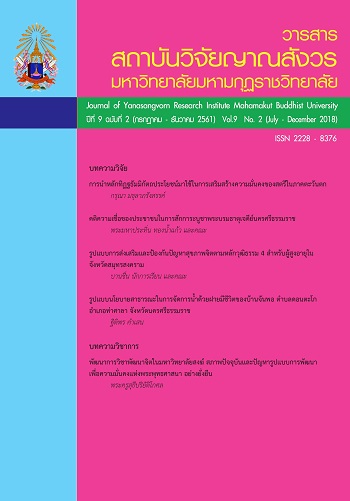DISCRIMINANT ANALYSIS FOR CHOOSING TO CONTINUE GRADUATE STUDY IN THE FACULTY OF EDUCATION, RAMKHAMHAENG UNIVERSITY
Main Article Content
Abstract
The objectives of the research were (1) investigate the factors affecting choosing to continue graduate study in the Faculty of Education, Ramkhamhaeng University, (2) compare the factors affecting choosing to continue graduate study in the Faculty of Education, Ramkhamhaeng University between students choosing to continue study and students choosing not to continue study, and (3) formulate the forecast function of students choosing to continue and not to continue graduate study in the Faculty of Education, Ramkhamhaeng University. The population of this research was a total of 667 students attending the commencement in the Faculty of Education for the academic year of 2014-2015 in Batch 41 and the students in the Faculty of Education for the Graduate Diploma in Teaching Profession. The questionnaires were used to divide opinions into 4 aspects, i.e., opinions on the institutional aspect with a reliability of 0.92, opinions on the socioeconomic aspect with a reliability of 0.75, opinions on the personal aspect with a reliability of 0.79, and opinions on the motive aspect to continue study with a reliability of 0.84. The data were analyzed by frequency distribution, percentage, and multiple discriminant analysis. The result of testing differences between students choosing to continue study and students choosing not to continue graduate study in the Faculty of Education, Ramkhamhaeng University showed differences between opinions on the institutional aspect (X 2), occupation (X1), opinions on the socioeconomic aspect (X3), and opinions on the personal aspect (X4) at the statistical significance of 0.05, whereas opinions on the motive aspect (X5) showed no differences. The variables having the highest weight in the discriminant function were opinions on the institutional aspect (X 2), followed by occupation (X 1), opinions on the socioeconomic aspect (X 3), opinions on the personal aspect (X 4), and opinions on the motive aspect to continue study (X5), respectively. The discriminant function was shown as follows: ZY = 0.810 ZX 2+0.631ZX 1+0.605 ZX3+ 0.563Z X 4+ 0.499 ZX5 The formulated function forecasted the members of students choosing to continue study and students choosing not to continue graduate study in the Faculty of Education, Ramkhamhaeng University accurately accounting for 59.37 percent.
Article Details
References
นันทิดา โฉมงาม. (2551). ความต้องการศึกษาต่อของนิสิตนักศึกษาปริญญาบัณฑิตทางการศึกษาหลักสูตร 5 ปี: การวิเคราะห์จำแนกกลุ่มพหุ. กรุงเทพมหานคร: จุฬาลงกรณ์มหาวิทยาลัย.
พงศ์ปณต เปลี่ยนอารมณ์. (2550). การตัดสินใจซื้อสินค้าเฮ้าส์แบรนด์: กรณีศึกษาห้างเดอะมอลล์. วิทยานิพนธ์เศรษฐศาสตรมหาบัณฑิต, มหาวิทยาลัยรามคำแหง.
วรวิทย์ รุ่งบุญพุฒิวงศ์. (2553). ปัจจัยในการเลือกศึกษาต่อหลักสูตรประกาศนียบัตรบัณฑิตวิชาชีพครูของมหาวิทยาลัยรามคำแหง. ศึกษาศาสตรมหาบัณฑิต สาขาการวัดและประเมินผลการศึกษา, มหาวิทยาลัยรามคำแหง
ศุภร เสรีรัตน์. (2544). พฤติกรรมผู้บริโภค (พิมพ์ครั้งที่ 3). กรุงเทพฯ: เอ-อาร์ บิซิเนสเพรส.
ทวีชัย วิริยะโกศล. (2541). ปัจจัยที่ส่งผลต่อความคาดหวังทางการศึกษาของนักเรียนชั้นมัธยมศึกษาปีที่ 3 เขตการศึกษา 1. ดุษฎีนิพนธ์ศึกษาศาสตรดุษฎีบัณฑิต, มหาวิทยาลัยมหิดล.
อดุลย์ วิริยเวชกุลม (2541). การส่งเสริมคุณภาพประกันคุณภาพระดับอุดมศึกษา.สำนักงานคณะกรรมการศึกษาแห่งชาติ, กรุงเทพฯ
Alder, A. (1930). Individual Psychology, In Psychology of 1930. Edited by C. Murchison Worcester Mass : Clark University. pp. 395-405
Morstain, Barry R. ; John C. Smart. (1974). Reasons for Participation in Adult Education Courses : A Multivariate Analysis of Group Differences. Adult Education. 24 ( 2 ).
National Institute for Adult Education (NIAE). (1971). The Year Book of Adulteducation. New York: McGraw-Hill


